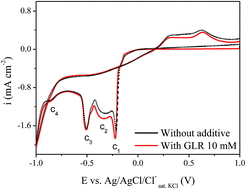Glycerol as additive in copper indium gallium diselenide electrodeposition: morphological, structural and electronic effects
Abstract
The co-electrodeposition of copper, indium, gallium and selenium from a pH 1.5 acid bath onto an FTO substrate in the presence of the additive glycerol (GLR) is studied. The concentration of additive in the bath is evaluated, and conditions are optimised for deposition of Cu(In,Ga)Se2 (CIGSe) thin films. The films are characterized by X-ray diffraction (XRD), scanning electron microscopy (SEM), Raman spectroscopy, ultraviolet-visible-near-infrared spectroscopy (UV-Vis-NIR), Mott–Schottky and photocurrent measurements. Mott–Schottky data, XRD and SEM studies reveal an improvement of the crystalline quality and the reduction the number of surface defects of the CIGSe films electrodeposited in presence of the additive. Photo-electrochemical and UV-Vis-NIR measurements show p-type photoconductivity with band gap of 1.34 eV.


 Please wait while we load your content...
Please wait while we load your content...